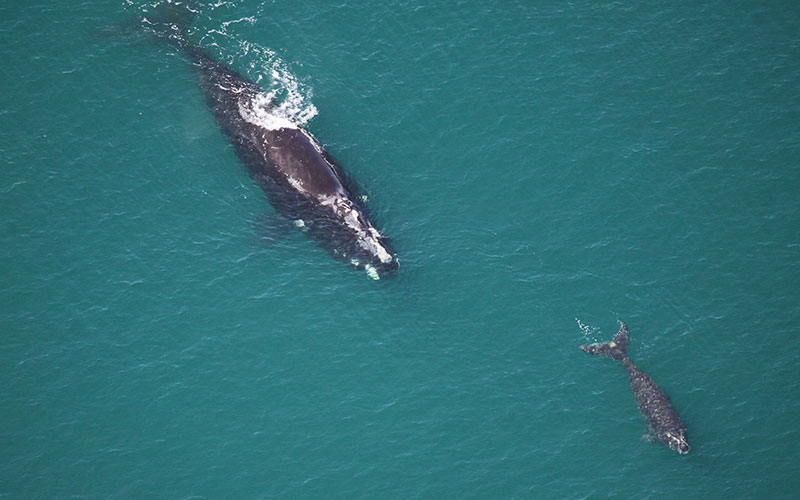
A right whale mother follows her young calf. Speeding boats and ships could put both at risk. Credit: Photo by Sea to Shore Alliance, taken under NOAA research permit #15488. S2S-Eg1620&calf-09MAR15-0132.jpg
Infinity, a North Atlantic right whale, was swimming alongside her one-month-old calf when a boat rammed them. Her baby died instantly, and Infinity received likely lethal injuries. The mother-calf pair were among the barely 350 remaining North Atlantic right whales. Infinity was one of just 70 fertile females. No one faced penalties for the avoidable accident. Mandatory speed limits designed to protect the critically endangered species didn’t apply to the boat.
Calving season for right whales officially began on November 15. Once again, it has arrived without the government taking any action to protect these precious calves from human-caused harm. Scientists say that at least 40 right whale calves must be born and survive each year for the population to recover. We can’t afford to lose a single calf to preventable threats like blows from vessels and entanglements in fishing gear.
Human-made threats endanger right whales and their calves
Back in 2008, NOAA instituted mandatory speed limits for ships and boats 65 feet and longer in limited locations at limited times of the year. Smaller boats are asked, but not required, to slow down in these same areas. This regulatory gap between which boats must slow down and which can choose to slow down leaves many large boats free to race through much of the migrating right whales’ territory.
NOAA hasn’t updated the rule since 2008, and they’ve refused to grant any of our legal filings urging them to change their policy. As a result, newborn right whales face a deadly obstacle course of zigzagging cargo ships, recreational boats, and other crafts as they travel from their birthplace in the southeast to their summer feeding grounds in the mid-Atlantic and off the coasts of New England and Canada.
We can protect right whales from boats
At the urging of CLF and our partners, NOAA has proposed regulations that expand when, where, and which boats and ships need to slow down. If these regulations had been issued and enforced sooner, Infinity and her calf would likely still be swimming off our coasts. These carefully crafted regulations are essential to ensuring we don’t lose more right whales to this preventable danger.
However, NOAA has already announced that they won’t be implementing their proposed update to the vessel speed regulations this year. Members of Congress have also tried to undermine NOAA’s authority by preventing the agency from implementing these badly needed reforms. Without these improved regulations, right whales remain at risk.
Protecting right whales is our responsibility
At this moment, pregnant right whales are already traveling south to their calving grounds. They are probably moving more slowly than usual, putting them at greater risk. The first calf of the season was spotted off the coast of South Carolina in late November, and more have already been sighted. Whether or not those mothers and calves survive their trip back up the east coast is largely up to us.
Right whale calves are incredibly valuable and incredibly vulnerable. The most lethal threats they face are human-made and avoidable. If we don’t act quickly, more mothers and babies will face the same fate as Infinity and her one-month-old. We know what steps will preserve the future of this critically endangered species. Letting another calving season pass without stepping up to protect right whales could prove catastrophic. Join us in calling on NOAA to implement their vessel speed rule to protect right whale babies and their mothers.




